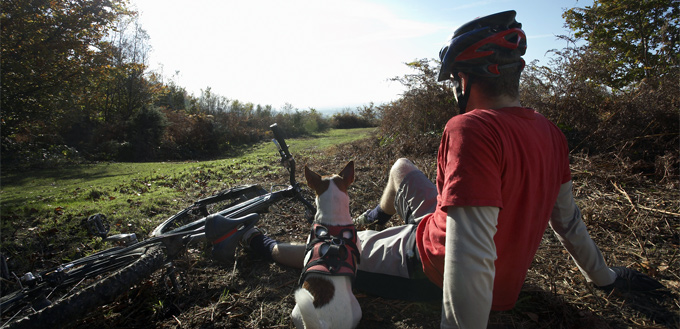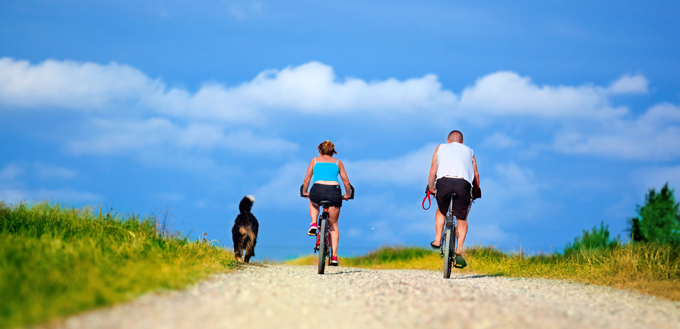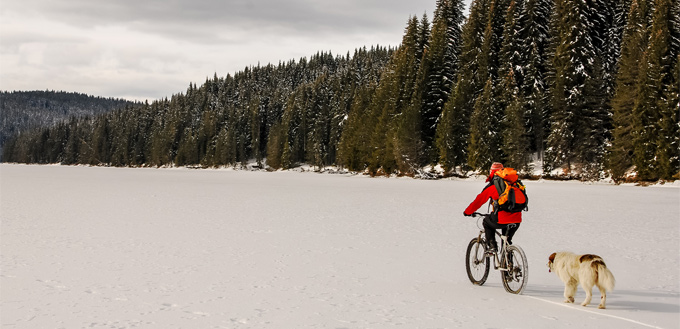Mountain bikers, dog owners, and dogs all share a love of the outdoors and nature. This means that it is a common hobby for dog parents everywhere. If you do love mountain biking then I’m sure you have considered taking your best friend with you, but maybe you don’t know where to start? We have some ‘Dos’ and ‘Don’ts’ to help you introduce your dog to mountain biking to make it a great hobby that you both can share.

Do’s for Mountain Biking With a Dog
Even if you have already begun to take your dog for biking trips, there are plenty of helpful ideas that could make the experience the best that it could be. Here we outline 7 tips, or ‘Dos’, that will make introducing your dog to biking as painless as possible:
1. Get Started Early
If your dog isn’t a pup anymore, it still isn’t too late to get them started, but it is best to start as early as possible. ‘Puppyhood’ is a great time to get your dog used to new and foreign objects. This is also true for your trail bike. Don’t hide your bike in the garage or out of sight. Put it in the hallway and let them safely investigate it. Move the bike around the home so they can figure out how the wheels work. After doing this for a few weeks, you might want to have a look at the best dog baskets for bikes so that they can sit in them as you move them. You could even try a small trip to the shops.
2. Try Bringing Your Bike On A Walk
The next step, after your dog has become used to the site and movement of the bike, is to take the bike on a normal walk. I don’t mean you should ride the bike, but get your dog used to its presence on walks. Make the first walk a small one along a familiar route so that your dog is confronted with very little change. Keep your dog on the leash, unless this is very different to their normal walking environment. Hopefully, this should begin an association for your dog between the bike and the fun of being outside.
You May Also Like: Dog Bike Leashes
You should also take this as the opportunity to teach your dog where to walk when out with a bike. Don’t let them walk directly in front of the bike. Have them walk behind the bike and to the side so that there is no risk of them coming into contact with the bike, even if it accelerates, suddenly veers to the side, or breaks. Use dog treats and positive reinforcement to ensure they learn the correct location to walk
3. Improve Your Dog’s Recall Training
Another great use for dog treats is to ensure that your dog has top-notch recall skills. Recall skills are their response to being called back to you. The best-trained dogs will come back to you when you call for them or whistle, even if they are distracted by something really enticing like a squirrel. This is essential during an expedition as you might be somewhere with poor visibility, like a forest, and if they are not on a leash while you are moving quite quickly, you could lose them. You also don’t want them getting in another trail users way, or running into roads. This is one of the most important traits your dog must have, for their own safety as well as others’.
You may also like our complete guides on: Dog Whistle Training and Best Dog Whistles
4. Play Hide and Seek
When your dog is ready to be off their leash, a great and fun way to improve your dog’s recall training is to play hide and seek. This will make your dog very used to finding you, and will positively reinforce finding you as a fun activity. Start in your garden, and then go to other familiar places where your dog is allowed off their lead. Tell your dog to sit and stay, while you go and hide. When you are ready, call for them, or use another, familiar call like a whistle. Don’t forget to reward them for finding you to reinforce the behavior.
5. Communicate
Recall training isn’t the only training that is important for trail dogs. There is a whole range of commands that are useful. You might use different variations, but your dog should be familiar with them all:
- ‘Stop’
- ‘Slow’
- ‘Drop it’
- ‘Hurry up’
You should always keep the line of communication open during when you mountain bike. Make sure your dog is very used to hearing these commands during walks, hikes, and any adventure. This should help them stay within earshot. You should also positively reinforce staying in earshot by rewarding their correct responses to these commands. Remember: dogs can also learn tone of voice, so be careful that you are making your meaning clear. Is this an urgent command, or a calm warning?
6. Check to See the Rules of the Area Your Are Riding In
There are many dog-friendly walks out there. But, there are also a few places that don’t allow dogs. You should try your best to be a conscientious dog owner and if somewhere has a ‘no dogs’ rule, it is probably for a reason. After all, you don’t want your dog to frighten a family of young ducklings or run under a dangerous, crumbling cliff face. It is easy to check online to see the rules of any place you are going to go, so make sure that you are adhering to any stipulations they request.
7. Put Your Dog’s Contact Information On Their Collar
Even the best-trained dogs might still wonder out of earshot and get lost. If that happens, you want to know that someone might help them find their way home. A good Samaritan can only do this if you have given them enough information to go on. A great way to do this is to attach your name and contact information to your dog’s collar. Dog collars can break and get lost, however, so you might choose to have your dog microchipped if you are really worried, particularly if you are planning on regularly going to very unpopulated areas where your dog might not find another human who can contact you.
You May Also Like: Dog ID Tags

Don’ts for Mountain Biking With a Dog
It often isn’t enough just to know what you should do, but it can be helpful to know the common mistakes people can make so that you can avoid them. To help you do that, we’ve compiled 7 of these pitfalls, or ‘don’ts’:
1. Include Friends Without Warning
Mountain biking can be a great social activity so you might be used to going with your mates. But, like every aspect of mountain biking with a dog, it is a bad idea to do this very suddenly. Before you can consider letting your dog join a group, you need to make sure:
- Your dog is well-trained and comfortable around your bike. This means they are responsive to your calls and consistently run in a safe position relative to your bike.
- Your dog is comfortable in groups of people. This means they don’t get overexcited or anxious. You might even want to invite a friend to accompany you on some walks with your dog and both your bikes to introduce them to the idea of more bikes and people.
- Your friends give consent to your dog joining you and know your dog’s commands in case of anything going wrong.
As a general rule, the safety of other trail users comes first, then your dog’s safety, then yours. Keep this in mind when trying to decide if bringing your dog is a good idea or not.
2. Push Your Dog
Some dogs can run for hours before they get tired, others can’t do as much. Even extremely fit dogs will start to get older, so keep in mind that their ability can change. Keep to their pace and watch out for signs that they are lagging. If in doubt, stop and take a break. There are all sorts of factors that impact stamina and ability. Dogs with short legs will struggle more than dogs with long legs, but they will often be happy to catch up. As always, start gradual and build up. If you want to go on particularly long trails, you should consider looking for the best dog bike trailers so you always have a place to put your dog if you think they are running out of steam. Trailers are also great for gradually introducing your dog to mountain biking as a safe place to put your dog where they can become comfortable with the bike before you trust them to run alongside it.
3. Forget Water and Snacks
It might seem basic, but it can be so easy to rush out of the house without packing water, even for yourself. Bring bottles of water for yourself, but don’t forget that your dog doesn’t drink in the same way that you do. Your dog will be doing just as much exercise as you are, if not more, so invest in dog water bottles so that you never risk dehydration. Similarly, you should also bring some snacks to re-energize you and your dog. A good tip is to always have plenty of water and snacks permanently in your car so that you are never caught without any.
4. Leave a Mess
Another thing you must take with you is poop bags. Again, you should have a permanent stock in the car, but remember to bring a few with you. There is nothing worse than being the unsuspecting victim of an inconsiderate dog owner who has just left their dog’s poop behind. The trail is probably used by all sorts of people who are running or hiking. I know the idea of carrying your dog’s waste with you for the rest of the journey might seem gross, but you can double bag it and put it in a separate carrier bag to be safe.
5. Leash Your Dog to Your Bike
This is dangerous and should NEVER be done. It is dangerous for the dog, who could be dragged or even choked if the leash is caught in the mechanism or you go too fast, and it is dangerous for you, as a distracted dog could pull your bike over. It will also make avoiding obstacles much harder. Your dog can no longer easily maneuver around trees, rocks or other trail users, and you have to take into account the extra width that your dog and their lead is creating.

6. Go In Very Hot or Cold Weather
Check the weather of the location you are going to as it might be hotter, colder, or wetter than it is where you currently are. Keep in mind that your dog is covered in fur, which will make running in hot temperatures even more of a challenge. Similarly, in cold weather, you might want to invest in a dog jacket or blanket. Also, be cautious about slippery surfaces, you might have trainers, boots or tires designed for great grip, but your dog only has their soft paws.
You May Also Like: Dog Winter Coats and Dog Cooling Vests
7. Start with Crowds
Even the most well-behaved dog has its bad days. Even if your dog is used to crowds, don’t assume that people will be happy to see him. Many people are scared, or allergic to dogs. While you should definitely avoid crowds in the early days of mountain biking, it is a good idea to be cautious and to do your best to avoid crowded trails as a general rule, even as your confidence in your dog’s abilities grows.







